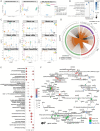This is a preprint.
Shared and unique 3D genomic features of substance use disorders across multiple cell types
- PMID: 39072016
- PMCID: PMC11275669
- DOI: 10.1101/2024.07.18.24310649
Shared and unique 3D genomic features of substance use disorders across multiple cell types
Abstract
Recent genome-wide association studies (GWAS) revealed shared genetic components among substance use disorders (SUDs). However, the extent of underlying shared causal variants, effector genes, and cellular contexts, remain unclear. We integrated 3D genomic datasets (high-resolution promoter-focused Capture-C/Hi-C, ATAC-seq, RNA-seq) from 59 diverse human cell types with recent GWAS summary statistics for alcohol (AUD), tobacco (TUD), opioid (OUD), and cannabis use disorder (CanUD). Using stratified LD regression, we determined the proportion of SNP heritability attributable to features in these cell types. We observed significant enrichments (P<0.05) in 25 cell types. Heritability reached 4.2-fold enrichment for CanUD in iPSC-derived cortical neurons and 6-fold for AUD/TUD in neural progenitors, confirming their relevance for functional exploration. Additionally, pancreatic cell types, notably insulin-secreted beta cells, showed heritability enrichment for TUD (4.8-fold) and CanUD (5.8-fold), suggesting genomic overlap with metabolic processes. Further investigation revealed significant positive genetic correlations between AUD, TUD, and CanUD with type 2 diabetes (T2D) (FDR<0.05). A multi-omic integrated assessment of T2D-SUD correlated loci revealed strong correlations between gene expression and chromatin accessibility at corresponding cis-regulatory elements and shared functional modules. Our study provides new genomic insights into SUDs and implicates specific cell types for targeted functional follow-up to pinpoint causal variant-gene mechanisms.
Conflict of interest statement
Dr. Kranzler is a member of advisory boards for Altimmune and Clearmind Medicine; a consultant to Sobrera Pharmaceuticals, Altimmune, and Lilly; the recipient of research funding and medication supplies for an investigator-initiated study from Alkermes and a company-initiated study from Altimmune; a member of the American Society of Clinical Psychopharmacology’s Alcohol Clinical Trials Initiative, which was supported in the last three years by Eli Lilly, Imbrium, and Indivior; and an inventor on U.S. provisional patent “Multi-ancestry Genome-wide Association Meta-analysis of Buprenorphine Treatment Response.”
Figures



References
-
- WHO, Global status report on alcohol and health 2018. 2018.
-
- SAMHSA, National Survey on Drug Use and Health. 2022: p. Table 2.25—Alcohol use in lifetime: among people aged 12 or older; by age group and demographic characteristics, 2021 and 2022.
-
- WHO, WHO global report on trends in prevalence of tobacco use 2000–2025. 2021.
-
- Ahmad FB, C. J., Rossen LM, Sutton P, Provisional drug overdose death counts. 2021, National Vital Statistics System: National Center for Health Statistics.
Publication types
Grants and funding
LinkOut - more resources
Full Text Sources
Research Materials
